| |||||||
| Search Forums |
| Advanced Search |
| Go to Page... |
 |
| Search this Thread |  41,154 views |
| | #1 |
| BHPian Join Date: Nov 2020 Location: Pune
Posts: 134
Thanked: 823 Times
| NCAP tests: Things to keep in mind as a buyer / misconceptions about NCAP After many days of pondering over whether or not I should start this thread, here I am. 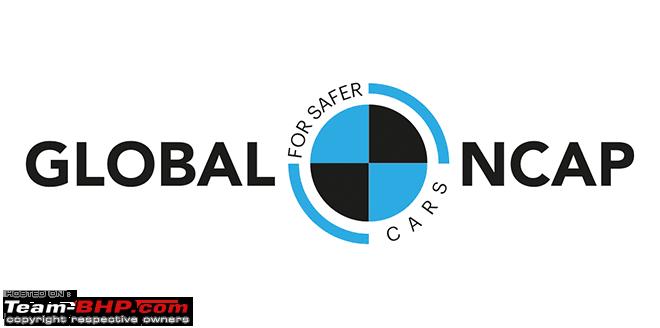 The latest wave of NCAP tests have sent shockwaves to all car buyers currently in the market and it has also shown exactly which corner was cut by what brand whilst selling a product. These tests are something that we should genuinely be grateful to. They have opened our eyes and have brought all the cards on the table for a new customer. One can only hope that NCAP begins testing all cars in the future. However, with the advent of these tests, the amount of misinformation and confusion being spread around various forums/media is immeasurable. Whilst TBHP certainly has considerably less misinformation, It is present nonetheless. So here I would like to address some of the common misconceptions and also give insight into how these tests are conducted. Do read the entire thread thoroughly. Last edited by Aditya : 16th December 2020 at 18:00. Reason: As requested |
| |  (51)
Thanks (51)
Thanks
 |
| The following 51 BHPians Thank superguy282 for this useful post: | .anshuman, akshye, ashking101, audioholic, Bibendum90949, chetancm7, Dani7766, digitalnirvana, dr.fixated, echo77, Emvi, fluidicjoy, FreeZaX, frewper, giri1.8, gischethans, greyhound82, GTO, guyfrmblr, haisaikat, Horizon85, InControl, klgiridhar, k_kumar, landcruiser123, logicalidiot, Napalm, ph03n!x, procrj, QuadraticAmoeba, RadixLecti, Researcher, ron178, RR96, sam264_2000, samaspire, saur95, Seenz, shancz, Shrayus_shirali, SnS_12, SS-Traveller, ssenhyd, SuhairZain, Tgo, theexperthand, Tom Sooraj, Ultim8, Utham123, Vasuki, vsrivatsa |
| |
| | #2 | ||
| BHPian Join Date: Nov 2020 Location: Pune
Posts: 134
Thanked: 823 Times
| re: NCAP tests: Things to keep in mind as a buyer / misconceptions about NCAP Method of testing We've all seen the videos of the GNCAP tests wherein cars traveling at a supposed 64km/h are crashed into a stationary blue barrier and get decimated. What we don't know, is the sheer amount of calculations,data and manhours involved in getting conclusions from these tests. To broadly classify the process: 1. Conducting the tests 2. Assessing the tests 3. Rating a car according to the data 1. Conducting the tests The real world parameters a car will face if involved in a crash, vary wildly. There are simply too many of them to begin with even without considering the variations present! Considering this most NCAPs conduct various tests, (read here). However GNCAP mostly conducts Frontal Impact tests of Moderate Overlap. In this test, a car is crashed on a deformable barrier covering 40% of the car (and thus reducing the impact area) whilst travelling at 64km/h. This test intends to replicate a head on collision of the car with another car of the same weight at 50km/h. The footage of this test is captured extensively using high fps cameras to determine how each and every part of the car moves when crashed.Which is also the reason the car is laden with stickers. It allows the measurement of deformation.(However this data isn't used to determine the ratings of the car, it is used for a greater study involving manufacturers to assess which parts to reinforce) Another test that is also conducted by GNCAP (when the vehicle is provided by the manufacturer) is the side impact test. A mobile barrier traveling at 64 km/h is struck on the car from the side. It also follows the same principle wherein it represents a car of the same weight being collided against the test car. This test is usually more brutal as there is little/no crumple zone present at the side. In order to score 5 stars, this test needs to be conducted. Moving on to the most complicated part. 2. Assessing the tests I'll let GNCAP do the talking, Quote:
Quote:
1. Chest Compression 2. Viscous Criterion (Which is basically the product of Velocity of Compression and the Amount of Compression. For more info, click here.) The first criteria has a Higher Limit of 22mm (if the compression is equal or below this value, it is awarded full points), and a Lower Limit of 50mm(if compression is equal or higher than this value, it is awarded 0 points). The higher limit estimates a 5% risk of serious injury and the lower limit estimates a 50% risk of serious injury! Do note that these risks vary with each body part individually and the chest has the biggest gap between the lower and higher parameters. The second criteria has a Higher limit of 0.5m/s and a lower limit of 1.0m/s, each representing 5% and 25% risk of severe injury respectively. This is how deep and calculated their assessment is. Even so, the organisation is continuously fine tweaking these parameters as more and more crash data is received. Now let's get to real world part. 3. Rating a car according to the data All these numbers seem really confusing and non-sensical to the average Joe. To simplify this, a fairly simple 0-5 star rating scale has been determined. Note:- These star ratings are as determined by EuroNCAP as GNCAP works on its basis and hasn't published any other meanings for these stars. Hence, the crash avoidance technology statements may not be accurate in the Indian scenario. But the crash protection statements are accurate. Each of the stars represent the following: 0 Star Safety : Meets Government safety norms and can be sold legally, However lacks critical modern safety features. 1 Star Safety : Marginal Crash protection and almost no crash avoidance technologies. 2 Star Safety : Nominal Crash protection but lacks crash avoidance technology. 3 Star Safety : Average Crash Protection but isn't equipped with latest avoidance features. 4 Star Safety : Good Crash protection and additional crash avoidance features are present. 5 Star Safety : Excellent Crash Protection and comprehensive and robust crash avoidance features are present. With this in mind, Let's take a look at how the points are calculated after getting individual scores from various regions of the body : (Note that I have considered only the Adult protection rating and not the child protection rating. If you wish to know about it too, check the links below) Firstly, body regions are grouped and the lowest score among these regions is counted as the score for the entire region. The groupings include, 1. Head and Neck 2. Chest 3. Knee,Femur and Pelvis 4. Leg and Foot. Accordingly after measurements (and rounding to 3rd decimal) of the parameters mentioned, the regions are colour coded. The colours represent : (out of 4.000 points) Green = 4.000 points Yellow = 2.670-3.999 points Orange = 1.330-2.669 points Brown = 0.001-1.329 points Red = 0.000 points And after all this, the final Star Rating is determined. With the corresponding score for each star being : (out of 16.00 points) 0 Star = 0.00-1.99 points 1 Star = 2.00-4.99 points 2 Star = 5.00-7.99 points 3 Star = 8.00-10.99 points 4 Star = 11.00-13.99 points 5 Star = 14.00-16.00 points A few other requirements for 5 star rating are 4 channel ABS, a seat belt reminder, and it must have a good score on the Side Crash rating. Keeping all this in mind, let's move on to the Misconceptions section. Also I have compressed and simplified the data (whilst maintaining context) for ease of reading, do check out the source if you wish for more info. Source Link(Adult), Link(Child) Last edited by Aditya : 17th December 2020 at 04:08. Reason: As requested | ||
| |  (64)
Thanks (64)
Thanks
 |
| The following 64 BHPians Thank superguy282 for this useful post: | .anshuman, advenk999, albertprince, alpha1, arjunsatheesh, ashking101, audioholic, Balaji31582, batman, Bibendum90949, Caadmara, CEF_Beasts, chetancm7, Dani7766, digitalnirvana, DrANTO, echo77, Emvi, fiat_tarun, FreeZaX, frewper, gischethans, Goku_YNWA, GTO, guyfrmblr, haisaikat, InControl, InterceptorGuy, jnanesh, klgiridhar, landcruiser123, lemedico, luvDriving, nitinkbhaskar, ph03n!x, procrj, QuadraticAmoeba, Rambo-RS, RedPhobos, Researcher, Rigid Rotor, RoadSurfer, sam264_2000, saur95, Seenz, shancz, shanezj, Shrayus_shirali, SnS_12, sridhar-v, SS-Traveller, ssenhyd, SuhairZain, Tgo, theexperthand, thush, Tom Sooraj, Ultim8, unk9ja, V.Narayan, vishal.jayakuma, VTec_KickedInYo, xjosephjacob, YashD |
| | #3 |
| BHPian Join Date: Nov 2020 Location: Pune
Posts: 134
Thanked: 823 Times
| re: NCAP tests: Things to keep in mind as a buyer / misconceptions about NCAP Misconceptions about GNCAP In no particular order, here are some of the misconceptions I've seen around the social media. --Comparison of Safety scores-- Kia Seltos barely managed to get a 3 star rating. That would make it comparable to a 2 Star Swift/WagonR/Santro yes? Tigor scored a 4 star rating, so I'm being given a car with safety of a Mahindra Marrazo/Thar because they scored 4 stars right? Unfortunately, No. Firstly as I've explained, the crash test simulates a collision with a car of the same weight, which is another reason why cross comparing car ratings between different segments is meaningless. Secondly, it has been proven time and again that, Bigger/ Heavier Car = Greater Safety Here are some numbers, 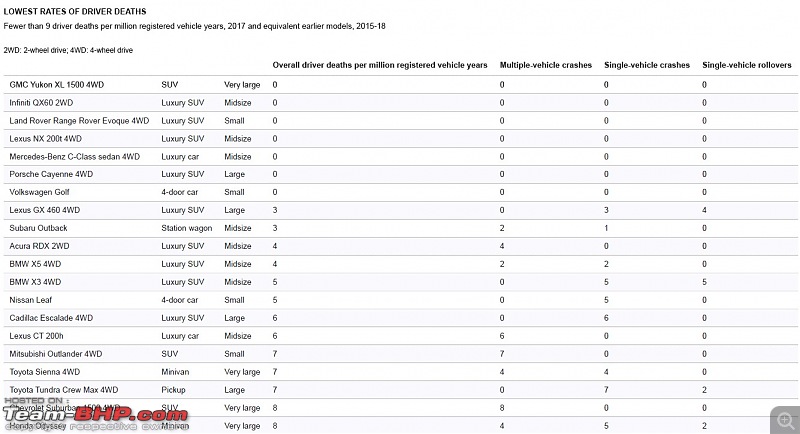 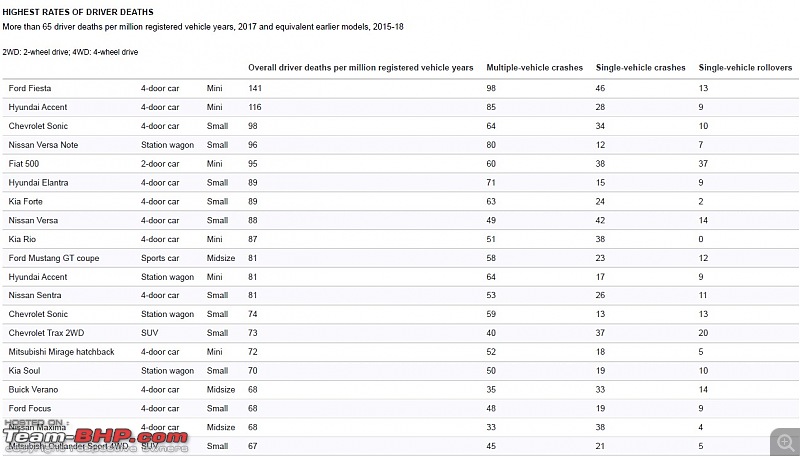 As seen in the tables made by the IIHS, the safest cars (Not in terms of safety rating but actual real world deaths!) Are all mostly SUVs whilst the Unsafest are dominated by the hatchback segment. A few surprises whilst conducting this study were the Volkswagen Golf and Nissan Leaf, which appear in the safest list. The study conducting body itself has acknowledged that the Golf's results are remarkable, considering the previous gen was one of the worst performers. As for the Nissan Leaf, the fact that it is an all electric vehicle could have affected when/where and how it was driven, hence the data may not be accurate. Another finding through this study deemed that the more the car is driven, the less likely it is to crash. Which would be obvious as the more you drive a vehicle, the more you can control it. But simply driving it more doesn't guarantee that a crash won't occur as you may/ may not be at fault. 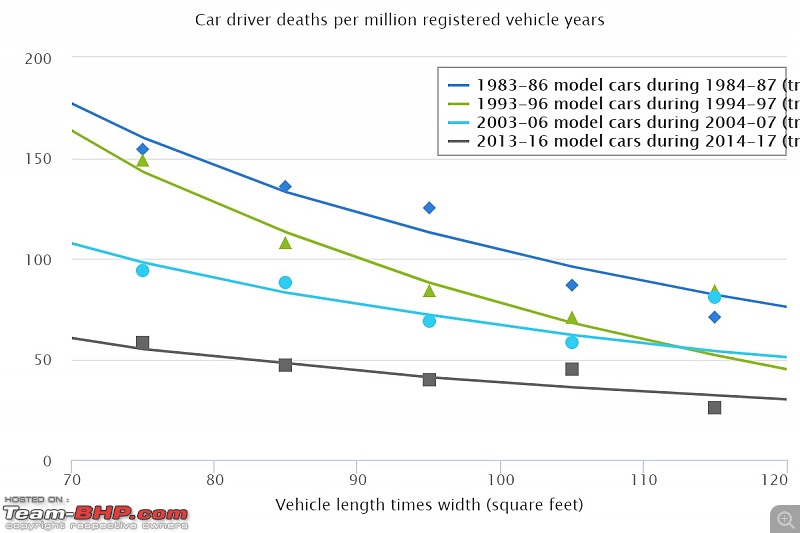 This is another chart by IIHS that shows the comparison of deaths per square feet area of the car! Again showing that bigger is better. German ADAC has also conducted many tests regarding this matter and have had similar results. Sources: Link, Link Counter Argument/T & C : -Simply tossing Sand bags in your car or adding a big heavy Chrome bullbar isn't going to make it safer. The entire structure has to be designed as one for it to dissipate the crash energy. -Older cars such as the Scorpio (0 star) are definitely UNSAFE compared to newer smaller cars having a higher safety rating. The Scorpio may not be mangled as much as the smaller car it's crashed with, but the occupants will surely have much, much more fatal injuries that of those in the smaller car with modern safety tech. Conclusion Safety scores can only be compared within the segment. --Effect of variants on safety scores-- GNCAP is a transparent organisation, releasing the footage from the crash testing immediately after the release of the crash scores. But due to this transparency, we have seen that some cars get tested with the Base model, whilst some of them are tested with the Top/Mid model. As no explanation is provided by GNCAP on the surface, most people cry foul. What they ignore in the process is that GNCAP has a policy to test the minimum safety your getting whilst buying a model. It doesn't rate variants for safety it rates the model itself. And more specifically, the variant which has the standard features available in all variants. Let's take a look at the Safety Feature distribution of a few cars: 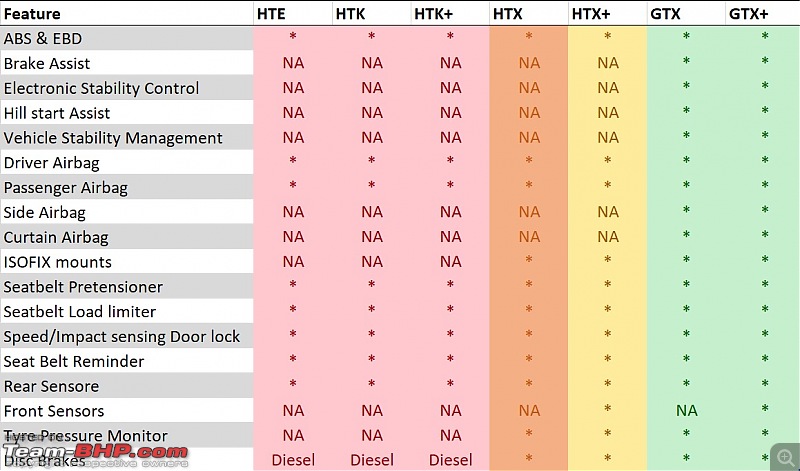 Here, the HTE-HTK+ variant of the Seltos get the safety features that are standard across all variants, hence the HTE was chosen for testing. 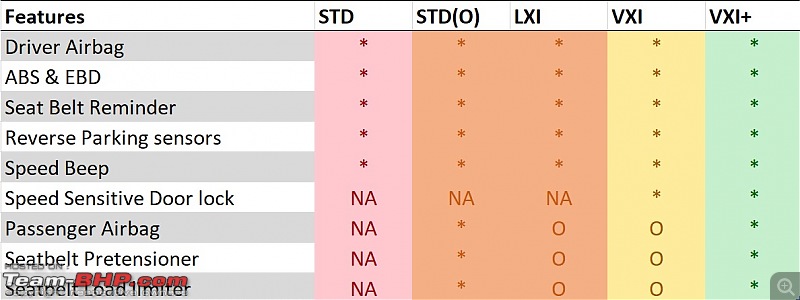 In case of the S-Presso, the Lowermost STD variant offers the safety features that are standard, hence this was the one chosen. 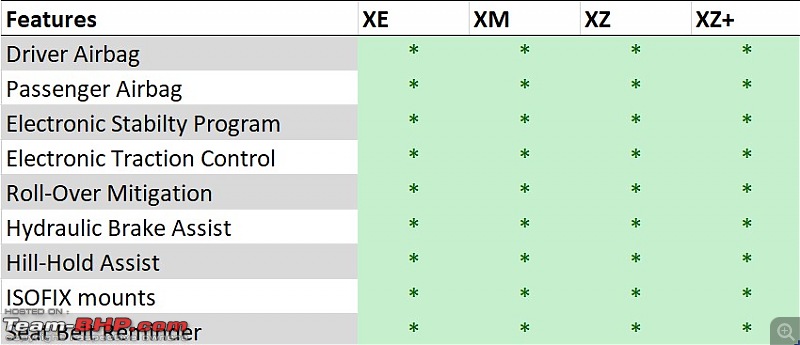 In case of the Nexon, the safety features are standard across all variants, hence no matter the variant, the rating will be the same. Now this brings us to an important point: - If the variant having the minimum safety feature is tested, would higher variants having additional safety features increase the crash rating? Yes, they will. One cannot comment how much of an increase it would be, but the crash rating will surely increase nonetheless. This also begs the question, why do manufacturers not test the top models of the respective cars voluntarily and release their scores seperately? - As I've mentioned above, NCAP tests models and not variants which is why even if the manufacturer sends in the top model for testing, it cannot publish the test scores unless and until all the safety features of that model are standard across the range. Recently the Mahindra Thar was tested and it scored a impressive 4 stars for the top variant. In order to publish these scores Mahindra had to kill off the lower variants that came with lesser safety features. Without doing so, GNCAP would've never given us the results. Counter-argument/T & C : - Unless the structure of the higher variants is altered, the structural integrity of the lower variants will be applicable to the higher variants as well. For e.g GTX+ model of Kia Seltos will still have it's structural integrity rated as Unstable even if the crash rating increases due to additional safety features. Conclusion GNCAP gives you the minimum amount of safety that your getting, and it may or may not be indicative of the safety that your particular variant demonstrates. --Sponsored GNCAP tests-- GNCAP is a NPO meaning it does not sell any data/earn any profits. This is Unlike EuroNCAP or IIHS which are government backed organisations operating on taxpayers money. Whilst this doesn't make the safety ratings GNCAP awards any less credible than those awarded by the other NCAPs, It severely reduces the number of vehicles being tested by it. GNCAP hasn't tested many vehicles, and usually picks vehicles that are most likely to sell/are selling in good numbers. Which is why many cars remain without a safety rating in the entire period in which they are sold. Which is why GNCAP has a provison for manufacturers to voluntarily send their models for testing. Tata, M & M, Honda, Renault are among the manufacturers to have sent cars voluntarily for testing. This has led to people thinking GNCAP is rigged/biased. What they do not know, is that vehicles are selected randomly straight from the production line by GNCAP officials themselves. Also if the manufacturer sends two units, one for the front impact test and one for the side impact test, that car is eligible to score 5 stars. This is another point that ticks people off. Merely sending your vehicle voluntarily in the required quantity does not guarantee a 5 star rating. The Mahindra Thar is a testimony to it. Despite sending two vehicles that were tested with eligibility for 5 stars, it scored 4 stars. On the other hand, one may argue that a 4 star car wouldn't be able to achieve 5 star rating even if it was capable of it. But then if the car is capable of 4 stars in the first place, there's a good chance that the manufacturer will send in the required units soon after the original test. The Nexon is a testimony to this statement. After it scored 4 stars when GNCAP tested it, Tata voluntarily sent two units for frontal and side tests. Lo! And Behold! The first 5 Star car made by an Indian Manufacturer was born. Counter-argument/T & C : Nil Conclusion Sending vehicles for testing voluntarily doesn't guarantee a 5 star rating. Neither is the test rigged. --Passive Safety vs. Active safety/Crash Avoidance-- In many of the various posts I saw, most of them had dismissed features such as ESP, Hill-Hold Control, Traction Control, Brake Assists, ISOFIX mounts, Seat Belt Reminders or even Speed alerts to be useless in GNCAP crash ratings. The posts above have enough to prove them wrong. Counter-Argument/T & C : -Gimmicky features may be advertised as Safety Features in a few cars. Spot them beforehand. Conclusion Apart from Passive safety (Strong Structure/Crumple Zones), Active Safety and Crash Avoidance Tech contribute in improving GNCAP results. --5 star safety rating guarantees safety-- This is one of the topics spreading like wild fire all around social media. People are taking safety in all scenarios for granted and are instilling in people's minds that simply owning a 5 Star car guarantees safety. Not only is this assumption wrong, it has already started to show it's effects. There will surely be exceptions, but I see too many Nexon drivers, driving like there's no tomorrow. Just yesterday when I was on the Mumbai-Pune Bypass a XUV300 was cutting trucks and cars left and right weaving through all traffic. I acknowledge that many cars regardless of their safety rating are driven in this fashion, but the idea of guaranteed safety is slowly but surely spreading. We must stop this as this will increase road accidents and fatalities rather than decrease them, which is the original purpose of GNCAP! Counter-argument/T & C : -Exceptions are present. Conclusion A 5 star safety rating doesn't guarantee safety in all scenarios and situations. Last edited by superguy282 : 15th December 2020 at 00:02. |
| |  (132)
Thanks (132)
Thanks
 |
| The following 132 BHPians Thank superguy282 for this useful post: | .anshuman, 2himanshu, abhkop, Added_flavor, akash_v12, akshay380, albertprince, Almoral, alpha1, anumod, arjunsatheesh, ashking101, asmr, Astitva, audioholic, Balaji31582, batman, Bibendum90949, blackwasp, BLACNWYTE, brownkaiser, BZ25, Caadmara, Capricorn, CarManMotorcycl, CarNerd, Cartik5477, charanreddy, chetancm7, condor, Crow, Dani7766, Deepsp, DeKay, demonoider, digitalnirvana, doc_zeus, dr.fixated, DrANTO, drrajasaravanan, echo77, Evyas, fiat_tarun, FlashMustang, fluidicjoy, FreeZaX, frewper, gauravanekar, giri1.8, gischethans, gowtham_vgc, graaja, GTO, gusfring, guyfrmblr, haisaikat, Hayek, icar, InControl, InterceptorGuy, iraharah, jagdish_ker, jithin23, JJay, jnanesh, Kashi053, klgiridhar, K_Drive, landcruiser123, lemedico, Lobogris, luvDriving, MaheshBapurao, MasterChief, mindovermotor, Napalm, navaneeth, Night Raven, nitinkbhaskar, ontheway, OrangeCar, pavanmadhini, ph03n!x, pranavtengshe, prasathlr, procrj, QuadraticAmoeba, r.joshi, Rambo-RS, RedPhobos, Researcher, Rigid Rotor, RoadSurfer, RockingHorse, RR96, RWD, sam264_2000, samaspire, satishchugh, saur95, Seenz, shancz, shanezj, sharktale, Shrayus_shirali, Simhi, SKC-auto, SnS_12, sridhar24, sridhu, srvm, SS-Traveller, ssenhyd, StepUP!, SuhairZain, TaurusSHO, Tgo, The Rationalist, The21st, theexperthand, thush, Tom Sooraj, Ultim8, unk9ja, V.Narayan, VaibhaoT, venkyhere, vigneshkumar31, VinNam, VTec_KickedInYo, xjosephjacob, YashD |
| | #4 |
| BHPian Join Date: Nov 2020 Location: Pune
Posts: 134
Thanked: 823 Times
| re: NCAP tests: Things to keep in mind as a buyer / misconceptions about NCAP To conclude, I would like to say this : There is simply no substitute for Driving Responsibly, whilst being Alert and respecting the Rules of the Road. Safety ratings will surely help You and your family stay safe and secure in any unfortunate incidents, but they too have their limits. Regardless, always consider buying the highest safety rated car you can, considering all the other parameters. Thank you for reading!  |
| |  (101)
Thanks (101)
Thanks
 |
| The following 101 BHPians Thank superguy282 for this useful post: | .anshuman, 2himanshu, Added_flavor, ajaiD, akash_v12, akshay380, audioholic, avinash_clt, Balaji31582, Bibendum90949, blackwasp, bpapache, brownkaiser, BZ25, CarManMotorcycl, Cartik5477, chetancm7, Crow, Dani7766, dark.knight, DevilzzzzOwn, digitalnirvana, dileepcm, dr.fixated, DrANTO, drhoneycake, drrajasaravanan, echo77, Evyas, FlashMustang, FreeZaX, frewper, GandalfTheGrey, gauravanekar, gischethans, gowtham_vgc, graaja, GTO, gusfring, guyfrmblr, haisaikat, Hayek, InterceptorGuy, iraharah, Kashi053, Keeleri_Achu, kkstile, klgiridhar, Lobogris, lokii_83, mi2n, mindovermotor, murthy_p, Napalm, navaneeth, NG_EV, Night Raven, nitinkbhaskar, NTO, papr23, pavanmadhini, ph03n!x, PPS, procrj, QuadraticAmoeba, Rambo-RS, RedPhobos, Researcher, robincsamuel, sakthivelm, samaspire, saur95, shancz, shanezj, Shrayus_shirali, SideView, sid__kaps, Simhi, SnS_12, srvm, SS-Traveller, ssenhyd, SuhairZain, TaurusSHO, Tgo, The Rationalist, theexperthand, thush, Tom Sooraj, Tucker48, Turbojc, unk9ja, V.Narayan, varunanb, venkyhere, Vijin, VinNam, VTec_KickedInYo, WorkingGuru, xjosephjacob, YashD |
| | #5 |
| Team-BHP Support  | re: NCAP tests: Things to keep in mind as a buyer / misconceptions about NCAP Thread moved out from the Assembly Line. Thanks for sharing! |
| |  (4)
Thanks (4)
Thanks
 |
| The following 4 BHPians Thank Aditya for this useful post: | digitalnirvana, GTO, Researcher, WorkingGuru |
| | #6 |
| BHPian Join Date: Jun 2019 Location: Bengaluru
Posts: 615
Thanked: 1,683 Times
| Re: NCAP tests: Things to keep in mind as a buyer / misconceptions about NCAP Good points and clarifications. I just hope/wish that the lunatics on road do not overspeed thinking that GNCAP rating of 5 means that they are safe from fatal crashes at all speeds. Obviously the higher the rating the better, but take every rating with a pinch of salt and do not be lulled into a false sense of security doing triple digit speeds. (These ratings arent going to help) Also wish that manufacturers stop false advertising car vs truck/train crashes where person came out unscathed. The person was lucky period.(if the other vehicle was overspeeding, scenario would have been way different) But good that these NPO are there testing vehicles and also publishing the results, else some manufacturers would have been least bothered about safety.  |
| |  (7)
Thanks (7)
Thanks
 |
| The following 7 BHPians Thank SideView for this useful post: | audioholic, gauravanekar, greyhound82, shancz, superguy282, TheHelix0202, VTec_KickedInYo |
| | #7 |
| Newbie Join Date: Oct 2017 Location: Bengaluru
Posts: 7
Thanked: 26 Times
| Re: NCAP tests: Things to keep in mind as a buyer / misconceptions about NCAP Thank you for this post, definitely needed and very informative! It really gives a good understanding on how these tests work and how the ratings are given. As your correctly pointed out, in the end we are responsible to follow the rules, be alert and as a customer choose to opt for a vehicle with more safety features. That being said it is commendable that tests like these prompt manufacturers to improve the level of safety standards across their range and for that they do deserve support and recognition. |
| |  (2)
Thanks (2)
Thanks
 |
| The following 2 BHPians Thank shanezj for this useful post: | klgiridhar, superguy282 |
| | #8 | |
| BHPian | Re: NCAP tests: Things to keep in mind as a buyer / misconceptions about NCAP Excellent article. My cousin asked my advice for a new automatic hatchback as a second car. I was happy when his son (who just got his license) insisted on getting the Tiago just because of it's safety rating. But the moment I got in to the car with him behind the wheel, I knew that even a 10* rated car cannot guarantee his safety. The sad part is that I know that it is not an isolated case. There are plenty like him who would've been given a false sense of security by high ratings. This article could help at least some of them. Talking about the article, I can see that the quoted part is lifted from Euro NCAP manual and not GNCAP. Quote:
For eg, A 2 star Swift and a 4 star Vitara Brezza comes standard with 4 channel ABS and dual airbags with seatbelt pretensioners. The only difference between them is the structural safety and actual forces experienced by the dummies. Last edited by Keeleri_Achu : 16th December 2020 at 08:10. | |
| |  (13)
Thanks (13)
Thanks
 |
| The following 13 BHPians Thank Keeleri_Achu for this useful post: | anb, Bibendum90949, chetancm7, digitalnirvana, fiat_tarun, gauravanekar, QuadraticAmoeba, Rigid Rotor, SuhairZain, superguy282, TheHelix0202, VTec_KickedInYo, xjosephjacob |
| | #9 | |
| BHPian Join Date: Nov 2020 Location: Pune
Posts: 134
Thanked: 823 Times
| Re: NCAP tests: Things to keep in mind as a buyer / misconceptions about NCAP Quote:
 Regardless, the meaning of the stars won't change for any NCAP, only the criteria required to meet a particular star will. This criteria is ever evolving and different for each country. And about the ABS part, I'm not exactly sure if 4-Channel ABS is standard across cars. As there exist cheaper alternatives that manufacturers could implement.(Types of ABS) But it might be true that 4 channel ABS is available in most cars. Last edited by Aditya : 16th December 2020 at 17:30. Reason: As requested | |
| |  (7)
Thanks (7)
Thanks
 |
| The following 7 BHPians Thank superguy282 for this useful post: | Almoral, Bibendum90949, digitalnirvana, gauravanekar, klgiridhar, Seenz, VTec_KickedInYo |
| | #10 |
| BHPian Join Date: Dec 2020 Location: KL
Posts: 135
Thanked: 692 Times
| Re: NCAP tests: Things to keep in mind as a buyer / misconceptions about NCAP Thank you for starting this thread, safety is one of the aspects which everyone is keeping an eye on recently. After viewing many GNCAP crash test videos one interesting thing came to my notice recently. In all tests front impact test were carried out and for cars which scored 4 or more stars side impact tests were also carried out. But I didn't find any cars tested for back impact. Is back impact not life threatening ? Last edited by RR96 : 16th December 2020 at 10:23. |
| |  (5)
Thanks (5)
Thanks
 |
| The following 5 BHPians Thank RR96 for this useful post: | Bagheera, Bibendum90949, gauravanekar, superguy282, VTec_KickedInYo |
| | #11 | |
| Senior - BHPian Join Date: Oct 2020 Location: Ranchi
Posts: 1,943
Thanked: 5,322 Times
| Re: NCAP tests: Things to keep in mind as a buyer / misconceptions about NCAP Quote:
 Thanks for bringing up the misconceptions and on a lighter note, if the manufacturer, who knows every bit of the car, cannot give a "guarantee" then how can 5 stars be a "guarantee" of invincibility . I hope our "safety-guaranteed" folks will find a way to this thread and get the point. Brilliant piece  | |
| |  (2)
Thanks (2)
Thanks
 |
| The following 2 BHPians Thank shancz for this useful post: | gauravanekar, superguy282 |
| |
| | #12 |
| BHPian Join Date: Mar 2020 Location: Sriharikota/BLR
Posts: 97
Thanked: 546 Times
| Re: NCAP tests: Things to keep in mind as a buyer / misconceptions about NCAP Excellent and much needed article. Shared with many of my friends and family members. I do see mostly the same arguments from them which you have mentioned here - those who have Nexon or equivalent rated car feel that they are indestructible while those who have a car rated less will argue that Global NCAP is biased and fakes ratings. Me being on the edge, tired of explaining (especially to my relatives), can't help but laugh on the inside after hearing their arguments refusing to understand  Crash is the last thing that happens. I feel, having traction control, brake assist, rear wash wipe, dimming mirrors, seat belt pretensioners etc (with dual airbags and ABS mostly standard now) are equally important in addition to having good crash worthiness. Cannot compromise on these features at all. These help to a great extent in avoiding a potential crash in the first place. Above all, as GTO mentioned, everyone should put their brain to better use and drive safely. But it is recommended to go with the safest car in the segment, provided we like the product in the first place. Last edited by klgiridhar : 16th December 2020 at 10:47. |
| |  (4)
Thanks (4)
Thanks
 |
| The following 4 BHPians Thank klgiridhar for this useful post: | gauravanekar, shancz, superguy282, VTec_KickedInYo |
| | #13 | |||
| BHPian Join Date: Nov 2020 Location: Poona
Posts: 55
Thanked: 341 Times
| Re: NCAP tests: Things to keep in mind as a buyer / misconceptions about NCAP Thank you for this excellent thread. I hope it gets at least 50% of the views that the 'Death Trap!', 'Guarantee Our Safety!', 'The Koreans Are Trying To Kill Us' Twitter-mob style responses to the initial thread got. Quote:
Quote:
Quote:
https://psychology.wikia.org/wiki/Risk_compensation | |||
| |  (5)
Thanks (5)
Thanks
 |
| The following 5 BHPians Thank RadixLecti for this useful post: | audioholic, gauravanekar, superguy282, VTec_KickedInYo, ynike99 |
| | #14 |
| BHPian Join Date: Dec 2020 Location: KL
Posts: 135
Thanked: 692 Times
| Re: NCAP tests: Things to keep in mind as a buyer / misconceptions about NCAP
I am a bit skeptical about this point. Are you mentioning this as a misconception or suggesting that heavier car is more safer. Heavier cars Scorpio ( when tested first ) scored cheaply in GNCAP tests suggesting greater injuries to passengers. The heavier cars in your list which are safer maybe safer according to NCAP scores too. I am not sure about this but need opinion from others about this. |
| |  (1)
Thanks (1)
Thanks
 |
| The following BHPian Thanks RR96 for this useful post: | Napalm |
| | #15 |
| Senior - BHPian Join Date: Apr 2011 Location: Pune
Posts: 1,155
Thanked: 1,956 Times
| Re: NCAP tests: Things to keep in mind as a buyer / misconceptions about NCAP Good writeup superguy282. While it is good to have a higher GNCAP rated car, we shall not assume ourselves to be safer in these cars. We must take due precautions for safe drive. Here is why: When a car collides head on, your whole body, which is travelling at the speed of car, typically at (60-120 km/h on highways) comes to rest in a fraction of a second (actually just 10 - 20 milliseconds). This gives a big jolt to your body. All the internal organs of the body (like the stomach, the liver, the intestines etc.) literally shake and move violently inside the body, suffering extensive damage. Even the organs like heart, lungs or brain, which are caged inside the bones, impact / press against those bone cages. Consequent internal injuries severely affect the internal organs. Such injuries take place due to jolt that the body gets, irrespective of the GNCAP ratings and structural integrity and crumple zones. The safer car may reduce the jolt a little bit but the organs are quite delicate and will be injured even in better GNCAP cars. Remember, though a person may survive an accident, but the life with injured organs is (most of the times) very miserable for the patient and his family. Also, don't be more confident because of better GNCAP while traveling wih a child. This is because most of us (almost all of us) don't use any dedicated child seats. Last edited by Rahul Bhalgat : 16th December 2020 at 11:12. |
| |  (10)
Thanks (10)
Thanks
 |
| The following 10 BHPians Thank Rahul Bhalgat for this useful post: | BZ25, demonoider, dr.fixated, gauravanekar, GeeTee TSI, paragsachania, procrj, shancz, Simhi, superguy282 |
 |


